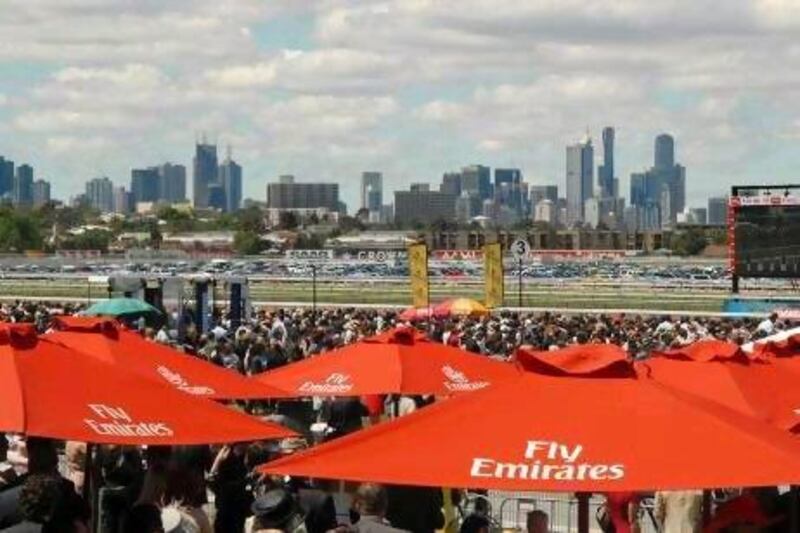As tourists disembark the airport shuttle at Southern Cross Station in Melbourne, the first sight their inevitably jet-lagged eyes will likely linger upon is a large and looming black-and-white sign attached to the top of a impressively grandiose sporting arena.
The sign reads Etihad Stadium. It is the first of several indicators that a relationship between the state of Victoria and the UAE is fast blossoming.
When Louise Asher, Victoria's minister for tourism and major events, visited the Emirates and Qatar last month as part of Australia's largest ever trade delegation to the Middle East, one of the first things she noticed was the similarities between the tourism policies of Gulf states and that of her home territory.
"It just struck me when I first arrived in Doha," she told The National this week. "Here was a country using sport to promote tourism, in an enormously similar way to what we have been doing here in the state of Victoria for many, many years."
Victoria has for over two decades now actively used sport as a means of promoting the Garden City. The Australian Open tennis championships moved to Melbourne Park in 1988, while the country's Formula One Grand Prix, which was won by Jenson Button this weekend, moved to Albert Park from Adelaide in 1996.
The UAE's tourism drive started slightly later - the inaugural Dubai Desert Classic in 1989 is often cited as the country's first major sports event - but it too has developed into a worldwide hub, with the Abu Dhabi Grand Prix, first held in 2009, arguably the jewel in the country's sporting crown.
Melbourne knows only too well the impact and importance of F1. According to a 2011 study by Ernst & Young, the Australian race increased Victoria's gross state product by between A$32.04 million (Dh123.804m) and $39.34m and created more than 400 jobs.
As well as the financial benefits, it has also helped Melbourne claim the title of "the world's sporting capital". Lewis Hamilton, ahead of Sunday's race, described it as "a city that has sport running through its veins" with a "crowd [that] lives and breathes it".
This year the grand prix attracted 313,700 spectators over the four days, the highest attendance since 2005, with 114,900 coming through the gates on race day.
The Financial Times reported that around 28,000 were from overseas with 80,000 hotel rooms sold over the race period. Last year’s event attracted 11,156 spectators from abroad, according to Asher.
"It's the perfect place to start the F1 season," said Button, Hamilton's teammate at McLaren-Mercedes. "The circuit's obviously very different to most circuits we drive - it's a street circuit - but it's a lot of fun."
Yet this year, like last, the stories off track have threatened to overshadow the preliminary action on the asphalt. As Michael Lynch wrote in Melbourne's daily newspaper The Age: "The annual debate over the future of the Australian Grand Prix is as much a signal of autumn starting as the football season kicking off."
While many Victorian taxpayers remain unhappy that their state government is being forced to pay $50m-plus per annum to keep the race afloat, Bernie Ecclestone, the sport's commercial rights owner has called for the grand prix to be held later in the evening – and thus at a more agreeable hour for television audiences in Europe – which would increase the cost significantly.
Asher told The National the state will not be bullied into anything it is not comfortable with.
“The track at Albert Park has no provisions and the government has no appetite to put in lighting,” she said.
“The timing of the race is very good for us, particularly with the Asian market which is very important here, so the government is not considering installing lights and has no intention of hosting a night race.”
Most observers consider Ecclestone’s stance as simply a Machiavellian way of garnering attention for his sport ahead of the season-opening race, but others contend that the rights owner likes to get his own way and with the Victorian government refusing to bow to the octogenarian’s calls, he could very well take his circus elsewhere when the Australian Grand Prix Corporation’s contract expires in 2015.
While Asher freely accepts the grand prix is vital to Melbourne’s sporting schedule, she makes it clear it is not untouchable, adding the state’s major event strategy in 2010 was valued by Ernst & Young at $1.4 billion.
“Sydney has the Harbour Bridge, Queensland has the Great Barrier Reef and central Australia has Ayers Rock,” Asher said.
“We have really had to market Melbourne as something else, as a place where you can do things. For that reason, the Formula One is obviously very important, but we have a range of other events which add significant increase [to the GSP]. Yes, the Australian Open and the grand prix are very recognisable, but we also have the Melbourne Cup and the [Australian Rules Football] AFL final.”
Both the Melbourne Cup and the AFL have ties to the UAE: the self-titled "Race That Stops a Nation" has been sponsored by Emirates since 2004, while the AFL headquarters are located in an arena with a black-and-white sign reading Etihad Stadium.
The UAE is helping Melbourne market itself to the world.





